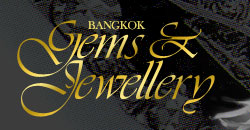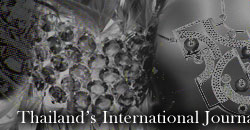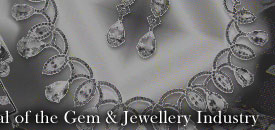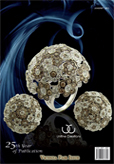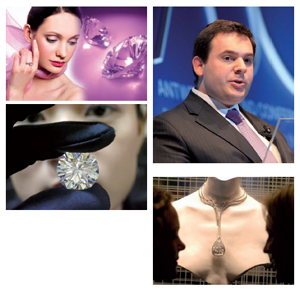| New Confederation Readies to Forge Thai Industry Unity | |||||||||||||||||||||||||||
|
|||||||||||||||||||||||||||
|
|||||||||||||||||||||||||||
| x | |||||||||||||||||||||||||||
|
|||||||||||||||||||||||||||
| x | |||||||||||||||||||||||||||
| Jewellers' Choice Design Awards | |||||||||||||||||||||||||||
A highlight of Dupuis’ Fall Sale of Fine Jewels
was a ring containing a very rare ruby of 7.62 carats. The stone, with a pre-sale estimate of
$350,000-$400,000, was sent to the Gubelin Lab in
Switzerland for examination and the report indicates
Burmese origin with “pigeon blood red” natural
colour. The catalogue cover piece is a 1920s ring set
with a 5.19 carat diamond of fancy vivid yellow, VS-
1 clarity. Among the other treasures is a very rare
0.98 carat fancy blue, VS-1, diamond ring; an
exquisite pair of natural pearl ear pendants; a
diamond ring by Gubelin set with a 4.18 carat
diamond of D colour and VVS-1 clarity. Dupuis Fine Jewellery Auctioneers was established by Ron Dupuis in 1986. Based in Toronto, Canada - but renowned both nationally and internationally - Dupuis and his team have made history over the past 25 years by selling jewels totalling more than $50,000,000. Dupuis has set the standard in Canada with its leading edge cataloguing style, user-friendly website and iPhone App. Each auction is broadcast live over the internet. The firm dominates the jewellery auction market in Canada with over 80% of market share by value of published Sale Results. |
|||||||||||||||||||||||||||
| A) An Art Deco 13.68 Carat Sapphire and Diamond Clip, Cartier, Circa
1925, estimate $70,000-$90,000. B) A Pigeon Blood Red 7.62 Carat Ruby Ring, estimate $350,000- $400,000. C) A Vivid Yellow 5.19 Carat Diamond Ring, circa 1920, estimate $60,000-$75,000. |
|||||||||||||||||||||||||||
The Property of HM Queen Elena of Italy and Her Descendants comprises 27 lots (lot 207-233) and is led by a finely pierced 1920s diamond bracelet, with a stunning floral motif, by Alfredo Ravasco. Ravasco created jewellery for the Royal House of Savoy, including presentation brooches for the Princess of Piedmont, later Queen Maria Jose of Italy. He was one of the few Italian jewellers to exhibit at the 1925 Exposition Internationale des Arts Decoratifs in Paris. Always a highlight of the sale, the regular Cartier section features over 50 lots, from jewels and cufflinks to watches, clocks and accessories. Jewellery highlights include a bold Art Deco panelled bracelet set with large circular cut diamonds, which epitomises the strong geometric design so sought after from this period, an attractive emerald and diamond bracelet mounted by Cartier in the 1950s, and a modern 'C' necklace, which is sold to benefit Iran's Children's charity. The finesse of Cartier cufflinks is demonstrated by a pair which is diamond-set and semi-circular in design; those featured in a refined emerald dress-set and a pair of emerald semi-circular gold cufflinks from the Property of HM Queen Elena of Italy and Her Descendants. Providing a veritable treasure trove of options for the discerning entleman, the selection of cufflinks-by other houses - continues throughout the sale, and includes an antique pair made of rock crystal and decorated with game bird paintings. |
|||||||||||||||||||||||||||
| Top diamonds fail to sell at New Work auction | |||||||||||||||||||||||||||
Is the American jewellery-buying public ahead
of the curve compared to general consumer buying?
Despite the country’s ongoing economic ills, with
obstinately high unemployment and a housing market
still in a state of disarray, U.S. consumers have been
increasing their purchases of jewellery for most of this
year. Indeed, whereas the American market has been underperforming Asia in other areas, when it comes to jewellery it is doing a better job of keeping pace. According to U.S. government figures, jewellery store sales for September jumped 14.6 percent on the year in the first three-quarters of 2011. And, while it is still early days yet, reports from the jewellery sector following the critical Thanksgiving Day weekend, which is traditionally regarded as the start of the Christmas shopping season in the United States, have been almost universally upbeat. In general, the mood of the American retail market is better than it has been in a while. Led by discretionary purchases, sales in October increased by 0.7 percent from September and by 4.7 percent over last October, the National Retail Federation said. However, the strong rise could have been due to early holiday promotions. “Retailers’ seemed to strike the right chord with shoppers last month,” said National Retail Federation President and CEO Matthew Shay. “Knowing the economy is still a big factor in customers’ shopping decisions, retailers will continue to offer great deals and exceptional value throughout the holiday season.” And the widely watched U.S. Conference Board Consumer Confidence Index, which had declined in October, showed an improvement in November, rising to 56.0 from 40.9 in October. The Present Situation Index and the Expectations Index both rose. “Confidence has bounced back to levels last seen during the summer,” said Lynn Franco, Director of The Conference Board Consumer Research Center. |
|||||||||||||||||||||||||||
| A) Mr. Matthew Shay B) Mr Ken Gassman | |||||||||||||||||||||||||||
“Consumers’ assessment of current conditions
finally improved, after six months of steady declines.
Consumers’ apprehension regarding the short-term
outlook for business conditions, jobs and income
prospects eased considerably. Consumers appear to be entering the holiday season in better spirits, though overall readings remain historically weak,” Franco added. What’s behind the rising sales in the U.S. market? According to noted diamond jewellery analyst Ken Gassman, one should look past the once-declining consumer confidence index or the fact that the American political system is deadlocked. “I say, ignore those factors,” Gassman said. “Unemployment is still high and the housing market is still very bad, but it is amazing that these factors do not seem to matter. They simply do not correlate to consumer sales. You would think that when times are bad, sales would also drop sharply, but that is not the case.” “There is a wellknown expression that when the going gets tough, people go shopping. Frankly, it is that simple. As far as jewellery is concerned, people are shifting money from other categories in order to give themselves a treat. After going through a tough period over the last three years, people want to reward themselves with something special. Americans are born to shop, and although there has been a slowdown in the past few years, the basic consumer mentality has remained in place,” he added. Gassman said that data from the U.S. Commerce Department showed that sales of jewellery were up 14.6 percent in the year to September despite rising prices for precious metals, while sales measured in dollar terms were up 12 percent. However, he believes a rise in the mid-to-high single-digit range seems more likely. “Over the next couple of years, I estimate that rises in jewellery sales gains will be around 4 percent annually,” Gassman said. |
|||||||||||||||||||||||||||
Up-market jeweller Tiffany & Co. reported a 63-percent rise in fiscal third-quarter earnings, with solid
sales growth in each of its eographic regions. Tiffany
reported a profit of $89.7 million for the quarter ended
October 31, up from $55.1 million from a year earlier.
Sales surged 21 percent to $821.8 million, or 17 percent
when stripping out currency fluctuations. Total samestore
sales soared 16 percent excluding currency
fluctuations, compared with a 7 percent rise last year.
Meanwhile, sales soared 24 percent at the company’s
Fifth Avenue flagship store in Manhattan, boosted by
the record number of tourists visiting New York. Tiffany has posted double-digit rises in profits in each quarter this year. In addition, same-store sales have been stronger than those its mid-range competitors with its consumers more willing and able to spend on gifts and other discretionary purchases. The firm reported a 17-percent increase in sales growth in the Americas, which accounted for most of the total sales. Further evidence of the rising strength of U.S. jewellery sales is seen in the financial turnaround at retail giant Zale Corp which operates more than 1,800 stores in North America. Indeed, the firm’s stock jumped close to 23 percent on one day in late September after Chief Financial Officer Matt Appel gave investors reassurance that its three-year turnaround program was working. Appel said that Zale was “trending in the right direction,” aided by the replacement of underperforming staff, rising revenue at stores open at least a year, and partnerships with celebrities such as Vera Wang and Jessica Simpson on exclusive product lines. The current situation is a large improvement on the decline the company underwent following the onset of the global financial crisis exactly three years ago. Zale Corp’s revenue figures slumped during the recession of 2009, hit by consumers slashing nonessential spending, difficult credit conditions as banks reduced their lending, and high unemployment. It has closed hundreds of stores over the past two years and moved top management around, as well as letting some go, as part of its turnaround program. |
|||||||||||||||||||||||||||
In the latest results, for its fiscal fourth quarter,
which it reported in late August, the chain posted an
increase in sales in its fiscal fourth quarter of 9.4 percent
from the same period of last year to $377.3 million. The
retailer said that same-store sales, an important pointerfor the direction of retailers, rose by 9.8 percent. The
company said that the fourth quarter was the third
consecutive three-month period of positive same store
sales. For the fiscal year 2011, Zale posted a 7.9-
percent increase in revenue to $1.74 billion. Also in the mid-range of the U.S. jewellery market, Signet Jewelers, the world’s largest specialty retailer of fine jewellery, reported that third-quarter sales jumped 10.7 percent on the year to $710.5 million. The jeweller’s results were boosted by a 10.6-percent increase in same store sales. Meanwhile, pre-tax income for the period ended October 29 was $42.1 million, up from $12 million for the third quarter of last year. Significantly, the company, which runs around 1,860 retail jewellery stores in the United States and Britain, said its third-quarter results were bolstered by U.S. sales, while its U.K. sales were more or less unchanged on the year. The company’s approximately 1,324 stores in the United States account for about 80 percent of annual sales, and posted a 13.3-percent rise in sales in the quarter to $563 million. Meanwhile, same store sales jumped 13.9 percent. Some analysts believe that reports of the decline of the U.S. jewellery market have been exaggerated. “It is true the United States’ share of the global jewellery market has fallen to around 40 percent from its long-time 50-percent share, but it remains the most important market in the world,” said James Porte, of the Porte Marketing Group. “In addition to discretionary spending on jewellery, there are 2.4 million weddings a year in the United States and 1.9 million engagement rings are sold,” he said. |
|||||||||||||||||||||||||||
| G) Mr. James Porte | |||||||||||||||||||||||||||
As for the general U.S. jewellery market, the
boost in jewellery purchases could be coming from
middle-level income earners making at least $100,000
who are feeling better about the economy and the super
rich, according to research firm Ipsos Mendelsohn. A study by the company based on interviews with more than 2,000 affluent people and 1,000 non-affluents over two months found that their consumer optimism was strong. But not all the news was good, as least from the jewellery sector’s perspective. The Ipsos Mendelsohn study also found that the consumer’s idea of what a luxury purchase was is changing and is highly subjective, with a two-hour massage, or a facial in a spa frequently fitting the bill. In other words, consumers are lowering the luxury bar, with many items far cheaper than jewellery fitting the bill. “That is a new component in the evolution of luxury,” the report said. Although traditional luxury brands were cited, such as Cartier, Louis Vuitton, and Patek Philippe, respondents also said luxury was less an issue of price than an experience, which could mean chocolate truffles, a fancy coffee machine, or imported cheese. Testimony of the changing nature of what constitutes a luxury product was provided by two-thirds of affluent respondents saying they define luxury differently today than they did even five years ago. In addition, affluent consumers do not believe that value pricing hurts a luxury brand. Among affluent people, 90 percent of affluents admitted to going out of their way to find the best price. “Fewer than half said true luxury is worth any additional cost and fewer than half also said true luxury does not go on sale, and even fewer said when a luxury product goes on it sale it lessens the perception of luxury. So consumers are bringing a very strong value orientation even to highest-ticket items.” “There is a strong sense that luxury is not stereotypical, but personal. Back in 2005 or 2006, there was a more shared sense of what luxury is, but today it’s much more personal and idiosyncratic. It’s about a feeling of ‘I deserve’ more than anything. And rarely were they talking about how it appears to others; it’s much more about self-gratification.” |
|||||||||||||||||||||||||||
| London NGO quits the Kimberley Process Over thriving blood-diamond trade | |||||||||||||||||||||||||||
This holiday season, the
question for spouses and lovers
receiving diamond jewellery
shouldn’t be whether he went to
Jared. It should be where those
diamonds came from before they
got to Jared — or Tiffany, or Macy’s,
or any corner jewellery store. An international agreement among diamond importing and exporting countries meant to prevent consumers from inadvertently buying so-called blood diamonds has been declared a failure and a lie by one of its main architects, the London-based NGO Global Witness, which has bailed out of the programme. The Kimberley Process, implemented in 2003 to end the trade in conflict diamonds, not only has failed to do so, the group says, but it may well be helping tainted stones make it to the market under cover of its own guarantees. “Nearly nine years after the Kimberley Process was launched, the sad truth is that most consumers still cannot be sure where their diamonds come from, nor whether they are financing armed violence or abusive regimes,” Charmian Gooch, a founding director of Global Witness, said in a statement. “It has become an accomplice to diamond laundering—whereby dirty diamonds are mixed in with clean gems.” |
|||||||||||||||||||||||||||
 |
|||||||||||||||||||||||||||
Global Witness’s very public
vote of no confidence is just the
latest blow to the Kimberley
Process’s credibility over its
handling of diamonds mined by
Zimbabwe, considered by many to
be the first real test of the scheme’s
ability to ensure that diamonds
mined in contravention of basic
human rights are not permitted into
a retail display case. The issue of
conflict diamonds first came to light
at the turn of the century, when
bloodthirsty rebels in Sierra Leone
hacked off the limbs of civilians to
scare them away from that country’s
rich mines, allowing the rebels to
sell gem-quality diamonds into
mainstream channels to finance
their campaign of terror. Sierra
Leone’s plight was highlighted in
the 2006 Leonardo DiCaprio movie
Blood Diamond. Lately, however,
Zimbabwe has become the poster
child for conflict diamonds. One of 75 Kimberley Process participants, Zimbabwe has rampant human-rights abuses at its Marange diamond fields that have been documented not only by organizations such as Human Rights Watch and news networks such as the BBC, but by the Kimberley Process itself. Since 2006, government forces loyal to President Robert Mugabe’s Zimbabwe African National Union–Patriotic Front party (ZANU-PF) have plundered the diamond fields, beating, killing, and sexually assaulting civilian miners. State security units use forced labour and child miners to dig their diamonds. |
|||||||||||||||||||||||||||
 |
|||||||||||||||||||||||||||
If ever there was a situation
the Kimberley Process was meant
to address, this seems to be it. But
rather than act decisively to kick
Zimbabwe out of the club and
condemn its actions, the Kimberley
Process has allowed it to continue.
At issue, at least in part, is its own
definition of conflict diamonds,
which are defined as those mined
by rebel groups fighting against an
established government. It doesn’t
address violent tyranny by a government against its own people. Bowing to political pressure from Zimbabwe’s regional neighbours—and hamstrung by its perplexing policy that every decision, including whether to suspend a member for noncompliance, must be unanimous—the KP greenlighted Zimbabwean exports this summer, declaring them to be in compliance with its rules. That means that in the eyes of the Kimberley Process, Zimbabwean diamonds are just as conflict-free as Russian or South African diamonds. That decision has led to a blowback in the diamond community, whose continued credibility in the eyes of the shopping public hinges on its claim that retailers aren’t selling blood diamonds to unsuspecting buyers. Martin Rapaport, who runs one of the world’s largest independent diamond exchanges, banned Zimbabwean diamonds from his network, whether or not they have Kimberley Process certificates. It was yet another no-confidence vote in the KP’s ability to keep the supply lines clean. |
|||||||||||||||||||||||||||
Just two months after the
Kimberley Process declared
Zimbabwean stones to be conflictfree,
Human Rights Watch reported
on August. 31 that “Zimbabwe
police and private security guards
employed by mining companies in
the Marange diamond fields are
shooting, beating and unleashing
attack dogs on poor, local
unlicensed miners.” Global Witness, which first raised the issue of conflict diamonds in 1998, had finally had enough. “It’s really time to acknowledge that it just isn’t working,” said Annie Dunnebacke, the organization’s senior campaigner, from the group’s headquarters in London. “It’s become such a lie—to consumers and to all the diamond-mining communities to whom the KP is represented as a mechanism that can protect their interests.” Dunnebacke said a particular concern was the possibility that diamond revenue could be used to finance a crackdown on Mugabe’s opponents leading up to next year’s election. “We don’t want to lend our credibility to, or be associated with, a scheme that could very well end up having blood on its hands if all this cash that KP has endorsed is used to fuel violence,” she said. “We don’t want to be a part of that.” Global Witness’s departure from the Kimberley Process comes two and a half years after another major supporter defected from the programme for similar reasons— the way the KP was dealing with Zimbabwe, among other complaints. Ian Smillie, one of the founders of the Canadian NGO Partnership Africa Canada, who helped shape and implement the Kimberley Process, sympathizes with Global Witness’s decision. “I think it’s perfectly understandable,” he said. “I got out of it two and a half years ago. I couldn’t stand to be part of a system that was taking two steps back for every step forward, and I think they finally realized that just staying in was not advancing the cause, that they could have more impact by leaving and working outside than by working inside.” Global Witness’s departure, he said, “is certainly significant. Whether it will have any impact on the Kimberley Process or not is another question. They seem impervious to criticism. They’ve been criticized for years … and it hasn’t made much difference.” Indeed, Eli Itzakhoff, the chairman of the World Diamond Council, whose job is to try to speak with one voice for the entire international diamond industry, called Global Witness’s move “regrettable,” but said he hopes that the coming year, in which the United States will assume the Kimberley Process’s rotating chairmanship, will be “very productive.” Regarding Zimbabwe, he referred to a statement posted on the World Diamond Council website that claims exports from certain companies operating in partnership with the Zimbabwean government have been certified as conflict-free. The Kimberley Process will “continue to hold the Zimbabwe government to account,” it reads, “and to allow only exports from those operations in Marange that have demonstrated compliance.” Such a promise rings hollow for its critics—the Kimberley Process isn’t meant to determine Mr Eli Izhakoff, President of the World Diamond Council addressing the Ms Annie Dunnebacke of Global Witness Kimberley Process plenum whether individual mining claims are compliant with its rules. “The Kimberley Process is a country compliance scheme, it’s a g o v e r n m e n t - t o - g o v e r n m e n t certification,” said Dunnebacke. “As a whole, Zimbabwe is not compliant with the Kimberley Process. There is no ‘company compliance’ with the KP … that is absolutely not what the KP is about, it’s not what it’s meant to do, it’s not what it’s equipped to do.” The World Diamond Council does share at least some of Global Witness’s concerns, however, especially with the Kimberley Process’s seeming inability to evolve. Like other critics, Itzakhoff blames the KP’s requirement for consensus on every decision, as well as its being an agreement among governments, which can be glacial in their pace of reform. “Industry is on the same page as the NGOs,” he said. “We want to have this thing done in a perfect way. It’s in our interest to do that. We’re doing everything in our power to make it happen. Moving along governments is not easy. You’re talking about [the need] to move mountains sometimes, but we have done so. There’s been a lot of pressure on governments to move and sometimes the pressure works. And this Global Witness walkingout will be another notch of pressure, but we didn’t need that because the pressure is there anyway.” That may be thin consolation for holiday shoppers looking for diamonds. As it stands now, a retailer can truthfully claim that a diamond in a necklace was certified as conflict-free by no less an authority than the Kimberley Process when it was a rough stone (the certification covers only rough diamonds, not polished ones), but still be from the hellish mines of Zimbabwe. So what’s a consumer to do? “The best thing that they can do is ask a lot of questions,” said Dunnebacke. “Our office is in London right near the Hatton Garden district, where all the diamond shops are. If everybody who went shopping for diamonds at Hatton Garden over Christmas, if every single person went into the jeweller and said, ‘I’ve heard there are blood diamonds from Zimbabwe, I don’t want a diamond from Marange, show me the work that you do to show me that you’re not selling blood diamonds,’ that would change things overnight. “If enough consumers ask for it,” she said, “then industry will have to come up with it. If you’re going to buy a diamond, buy from jewellers who are open about what they actually do and don’t know.” |
|||||||||||||||||||||||||||
|
|||||||
